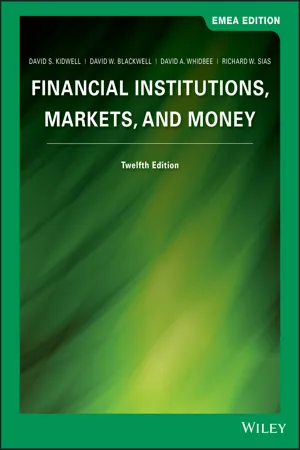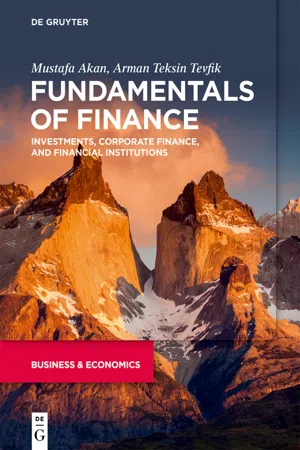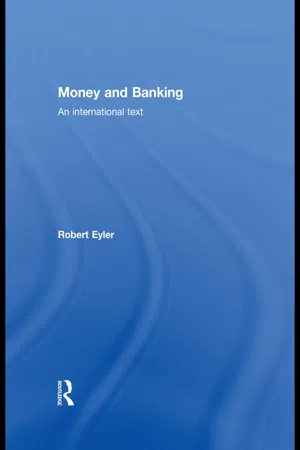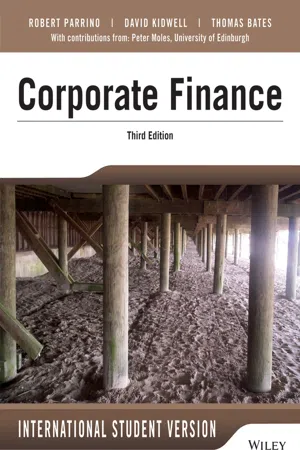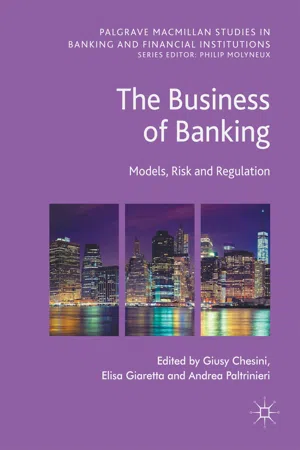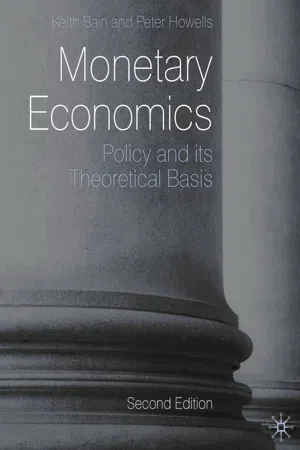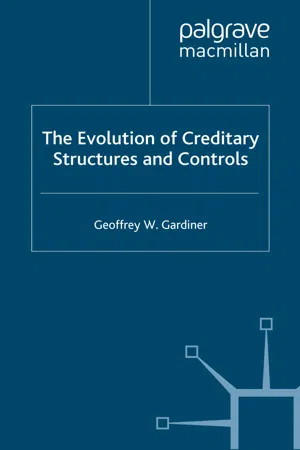Economics
Bank Interest Rates
Bank interest rates refer to the percentage charged or paid by a financial institution on funds held by customers. These rates impact borrowing and saving costs for individuals and businesses, influencing spending and investment decisions. Central banks often use interest rates as a tool to control inflation and stimulate economic growth.
Written by Perlego with AI-assistance
Related key terms
1 of 5
12 Key excerpts on "Bank Interest Rates"
- eBook - PDF
Financial Institutions
Markets and Money
- David S. Kidwell, David W. Blackwell, David A. Whidbee, Richard W. Sias(Authors)
- 2020(Publication Date)
- Wiley(Publisher)
This chapter explains the role of interest rates in the economy and provides a basic explanation of the fundamental determi- nants of interest rates. The chapter serves as a foundation for Chapters 5 and 6, which also deal with interest rates. ■ vectorfusionart/Shutterstock Even though we understand the factors that cause interest rates to change, only people who have a crystal ball can predict interest movements well enough to make consistent profits. The gutters of Wall Street are littered with failed interest rate prediction models. 4.1 WHAT ARE INTEREST RATES? For thousands of years, people have been lending goods to other people, and on occasion, they have asked for some compensation for this service. This compensation is called rent— the price of borrowing another person’s property. Similarly, money is often loaned, or rented, for its purchasing power. The rental price of money is called the interest rate and is usually expressed as an annual percentage of the amount of money borrowed. Thus, an interest rate is the price of borrowing money for the use of its purchasing power. To a person borrowing money, interest is the penalty paid for consuming income before it is earned. To a lender, interest is the reward for postponing current consumption until the maturity of the loan. During the life of a loan contract, borrowers typically make periodic interest payments to the lender. On maturity of the loan, the borrower repays the same amount of money borrowed (the principal) to the lender. Like other prices, interest rates serve an allocative function in our economy. They allocate funds between surplus spending units (SSUs) and deficit spending units (DSUs) and among financial markets. For SSUs, the higher the rate of interest, the greater the reward for postponing current consumption and the greater the amount of saving in the economy. - eBook - PDF
Fundamentals of Finance
Investments, Corporate Finance, and Financial Institutions
- Mustafa Akan, Arman Teksin Tevfik(Authors)
- 2020(Publication Date)
- De Gruyter(Publisher)
Interest the borrower pays to a bank is also the rent the borrower pays to the bank. Benchmark interest rates include the London 1nterbank Offered Rate (or LIBOR), which is a daily reference rate based on the interest rates at which banks offer to lend unsecured funds to other banks in the London wholesale money market (or interbank market). LIBOR will be slightly higher than the London Interbank Bid Rate (LIBID), the rate at which banks are prepared to accept deposits. Interest rates often represent a benchmark rate for comparison with investment opportunities. Prime rate was a term applied in many countries to a reference interest rate used by banks. Some variable interest rates may be expressed as a percentage above or below the prime rate. As such, interest rates affect depository institutions (savings and loans), financial institutions (insurance companies and pension funds), financial markets (home mortgages), and securities markets (stocks and bonds). There are two major theories regarding interest rates: – The Loanable Funds Theory : Classical or Real Theory , which explains interest as determined by the demand for and supply of capital. 3 – Keynes ’ s Liquidity Preference Theory , which explains that the rate of interest is higher on securities with long-term maturities. Loanable Funds Theory Interest rates are affected by supply and demand of funds, as shown in Figure 2.1. The loanable funds theory suggests that interest rates are a function of the supply and demand for funds earmarked for loans. Savings may also have an effect on in-terest rates; the volume of saving depends on factors such as income, tax rates, and the demography of the population. Generally, interest rates rise during periods of prosperity, since people increase their level of consumption due to their increased 3 For more detailed information, see Peter Howells and Keith Bain, Financial Markets and Institutions , Fifth Edition, Pearson Education, 2007, pp. - eBook - ePub
Money and Banking
An International Text
- Robert Eyler(Author)
- 2009(Publication Date)
- Routledge(Publisher)
Something we will explore in depth when we talk about money demand later is the idea of the interest rate as the opportunity cost of having cash in your pocket. This relationship between the quantity of cash or liquidity demanded and the interest rate is of key importance to a great deal of macroeconomic theories but also to monetary and fiscal policy in practice. The way consumers react to changes in interest rates paid on their cash holdings changes the demand for goods and services, as well as the demand for lending. However, for now the idea is simple: the interest rate is the opportunity cost of holding money in your wallet rather than in an interest-bearing account or investment.Measure of time preference
It is this definition that links the three above and binds them in the household’s eyes. When you chose to consume more than your income, or consume with credit rather than paying in full, you are making a choice about your time preference to consume. The interest rate is a measure of how people prefer to consume with respect to time: if the interest rate falls, there will be marginal changes in consumption based on a smaller cost of credit. Certain households which initially would save, say $1000, now spend $100 of that $1000 and save only $900. They still save a certain amount, but it is less. The lower interest rate has triggered an incentive for them to spend on credit, or prefer to spend now than later in time.The cost of borrowing falls in the previous example, providing an incentive to borrow. Certain lenders must provide the loan, thus they see the interest rate as the revenue from lending, and want to take advantage of it. Finally, the borrower must demand cash in order to spend, thus the cost of holding money must also be going down at the same time, and intuitively it does. The interest rate is all four of these ideas simultaneously, and must be for financial markets to work correctly. We will see later that the interest rate’s measure of time preference characteristic makes the entire economy work correctly. - Tan Chwee Huat, Kwan Kuen-Chor, Tan Chwee Huat, Kwan Kuen-Chor(Authors)
- 2014(Publication Date)
- Butterworth-Heinemann(Publisher)
Chapter 3 Interest Rates and Credit Mohamed Ariff 3.01 Introduction Financial institutions and markets discussed in the last chapter can be thought of as a loosely organized network for dealing with loanable funds in an economy. The loanable funds form the potential credits available to economic agents, namely, the firms, the government and the individuals. We turn our attention to understanding how interest rates determine the amount of loanable funds available as credits for economic activities. Interest rates may be thought of as the cost of borrowing the funds. Institutions provide a myriad of financial services such as lines of credit, term loans, negotiable certificates of deposits (NCDs), etc at a cost to creditors for making the funds available. Some organizations such as the companies listed in the organized exchanges and the government can issue financial instruments at stated or implied cost for having access to funds. This chapter attempts to describe this process by examining how the interest rates are determined in the market. An understanding of this process is very important to investors since interest rates will affect the outcomes of various investment activities of firms and individuals. 3.02 Interest Rates Business organizations and the government are the biggest borrowers of funds: the former require funds for undertaking real investments, and the latter for developing the economy and the social structure (education for example). Firms are faced with a number of profitable opportunities which will (1) extend the life of existing productive facilities and (2) offer new opportunities for investment which provide future benefits. These opportunities, let us call them investment schedules, are the objects of choice. Firms bid for funds in the market to undertake investments. Figure 3.1 illustrates the process of estimating the benefits of the investment schedules against the cost of getting these funds: management 39- eBook - PDF
Mathematical Interest Theory
Third Edition
- Leslie Jane Federer Vaaler, Shinko Kojima Harper, James W. Daniel(Authors)
- 2019(Publication Date)
- American Mathematical Society(Publisher)
C H A P T E R 10 Determinants of interest rates 10.1 INTRODUCTION 10.2 SUPPLY AND DEMAND OF LOANS 10.3 DEFAULT RISK 10.4 INFLATION RISK 10.5 BANKS AND OTHER FINANCIAL INTERMEDIARIES IN THE RETAIL SEC-TOR 10.6 SAVINGS AND LENDING INTEREST RATES IN THE RETAIL SECTOR 10.7 BONDS ISSUED BY GOVERNMENTS AND CORPORATIONS 10.8 THE ROLE OF CENTRAL BANKS 10.9 PROBLEMS, CHAPTER 10 10.1 INTRODUCTION In Section (1.2), we defined interest as the charge a borrower pays to a lender to gain access to money. So far, we either performed calculations from given interest rates or were given enough facts about a transaction to calculate the interest rates, but we have not discussed how the level of the interest rates are determined. The term of the loan is a factor as we have seen in Section (8.3). However, we will see that there are other factors such as the effect of supply and demand, the likelihood that a loan will not be completely repaid, and the fluctuation of the purchase power of money. Furthermore, the wide variety of what we refer to as loans from personal consumer loans to corporate bonds gives rise to factors that are particular to that loan product. We will examine some broad categories of loans, then conclude the chapter with a brief expo-sition concerning the roles a central bank plays in determining interest rates. 10.2 SUPPLY AND DEMAND OF LOANS Money can be used to purchase goods and services. A person who has money can choose to spend it now or to save it for later use. Spending now may provide instant gratification, but offered enough compensation, one may be 503 504 Chapter 10 Determinants of interest rates persuaded to lend (invest) the money instead. When the loan is repaid, the lender should have more to spend than what he started with. Interest is the compensation for deferring consumption. - eBook - PDF
- Robert Parrino, David S. Kidwell, Thomas Bates(Authors)
- 2016(Publication Date)
- Wiley(Publisher)
The interest rate at which the supply of funds equals the demand for those funds is the equilibrium rate. The amount lender-savers want to lend (L) goes up as interest rates go up and lending becomes more profitable. Equilibrium rate of interest The equilibrium rate of interest ( r ) is the rate at which the desired level of lending (L) equals the desired level of borrowing (B). Equilibrium quantity of lending/ borrowing Interest rate (%) r L = B B L Quantity of lending/borrowing in the economy ($) The amount borrower-spenders want to borrow (B) goes down as interest rates go up and borrowing becomes more expensive. 2.7 The Determinants of Interest Rate Levels 53 Loan Contracts and Inflation The real rate of interest ignores inflation, but in the real world, price-level changes are a fact of life and they affect the value of a loan contract or, for that matter, any financial contract. For example, if prices rise (inflation) during the life of a loan contract, the purchasing power of the loaned amount decreases because the borrower repays the lender with inflated money – money that has less buying power. 9 To see the impact of inflation on a loan, we will look at an example. Suppose that you lend a friend €1 000 for one year at a 4 per cent interest rate. Furthermore, you plan to buy a new mountain bike for €1 040 in one year when you graduate from university. With the €40 of interest you earn (€1 000 × 0.04), you will have just enough money to buy the mountain bike. At the end of the year, you graduate and your friend pays off the loan, giving you €1 040. Unfortunately, the rate of infla-tion during the year was an unexpected 10 per cent and your mountain bike now will cost 10 per cent more, or €1 144 (€1 040 × 1.10). You have experienced a 10 per cent decrease in your purchasing power due to the unanticipated inflation. The loss of purchasing power is €104 (€1 144 − €1 040). - eBook - PDF
- Scott Besley, Eugene Brigham, Scott Besley(Authors)
- 2021(Publication Date)
- Cengage Learning EMEA(Publisher)
115 CHAPTER 5: The Cost of Money (Interest Rates) Copyright 2022 Cengage Learning. All Rights Reserved. May not be copied, scanned, or duplicated, in whole or in part. Due to electronic rights, some third party content may be suppressed from the eBook and/or eChapter(s). Editorial review has deemed that any suppressed content does not materially affect the overall learning experience. Cengage Learning reserves the right to remove additional content at any time if subsequent rights restrictions require it. 3. When the U.S. economy shows signs of expanding too quickly, the Fed normally takes actions to increase interest rates to discourage too much expansion and to control future growth so that it does not result in high inflation. 4. During recessions, short-term rates decline more sharply than do long-term rates. This situation occurs for two reasons. First, the Fed operates mainly in the short-term sector, so its intervention has the strongest effect here. Second, long-term rates reflect the average expected inflation rate over the next 20 to 30 years. This expecta- tion generally does not change much, even when the current rate of inflation is low because of a recession. 5-5 INTEREST RATE LEVELS AND STOCK PRICES Interest rates have two effects on corporate profits. First, because interest is a cost, the higher the rate of inter- est, the lower a firm’s profits, other things held constant. Second, interest rates affect the level of economic activity, and economic activity affects corporate profits. Interest rates obviously affect stock prices because of their effects on profits. Perhaps even more important, they influence stock prices because of competition in the marketplace between stocks and bonds. If interest rates rise sharply, investors can obtain higher returns in the bond market, which induces them to sell stocks and transfer funds from the stock market to the bond market. - eBook - PDF
The Business of Banking
Models, Risk and Regulation
- Giusy Chesini, Elisa Giaretta, Andrea Paltrinieri, Giusy Chesini, Elisa Giaretta, Andrea Paltrinieri(Authors)
- 2017(Publication Date)
- Palgrave Macmillan(Publisher)
In fact, a high percentage of debt in many countries has negative interest rates. According to a recent analysis by the International Monetary Fund (2016), the expansionary monetary policies adopted by some central banks have eased the access to finance (by reducing the cost of funding and increasing the availability of credit), thus stimulating aggregate demand. However, a prolonged period of reduced interest rates can impair bank intermediation margins (and therefore profitability), given the existence of a floor in deposit interest rates, since it is dif ficult for banks to pass on the drop in interest rates to the deposits interest rates, at least in the case of households. 2 For this reason, the net interest margin is seen to be most affected in those banks with a greater proportion of financing via deposits. Likewise, the greater the proportion of variable interest rate loans in a bank, the greater the deterioration of its 0.00% 1.00% 2.00% 3.00% 4.00% 5.00% 6.00% 7.00% 2003 2004 2005 2006 2007 2008 2009 2010 2011 2012 2013 2014 2015 European Central Bank (ECB) Bank of Japan (BoJ) Bank of England (BoE) Federal Reserve (Fed) Fig. 2.1 Intervention interest rates by the main Central Banks. Source: Bank of Spain. 6 P. Cruz-García et al. profitability, as a result of the fall in financial revenues due to the reduction of the money market interest rates. The European Central Bank (2016), on the other hand, highlights in its Annual Report that the expansionary measures adopted have a positive impact. The positive impact is driven by the fact that the drop in interest rates has led to an improvement in the quality of bank assets (since less risky projects are financed), an increase in lending activity and a drop in non-performing loans as a result of economic recovery. - eBook - PDF
Monetary Economics
Policy and its Theoretical Basis
- Keith Bain, Peter Howells(Authors)
- 2017(Publication Date)
- Red Globe Press(Publisher)
Other things being equal, the Interest rates as the policy instrument 101 demand for loans (and the demand for deposits) expands over time since both are related to nominal income and this increases as a result of both increases in real income and in the price level. (This is why, when the UK authorities have been concerned about the size of the monetary aggregates — after 1973 and most obvi-ously between 1980 and 1985 — it has been the growth rate and not the absolute size which has been the focus of attention). It is thus a fairly simple task for the central bank to ensure that the quantity of monetary base (of which reserves are a part — see equation 3.2) grows slowly enough that at the end of each day the banks involved in the settlement process are short of funds (Bank, 1997a). In addition to this, a large fraction of banks’ liquidity consists of previous short-term borrowing from the central bank. When these loans mature (‘unwinding of offi-cial assistance’ in the jargon) they need to be refinanced. Provided that the short-age is system-wide, interbank lending and borrowing cannot resolve the shortage and the central bank is then in the position to exploit its monopoly position in the supply of reserves. Like any monopolist, the central bank can set either the price or the quantity of reserves which it supplies. In choosing to set the rate of interest at which is sup-plies or refinances reserves, central banks are choosing to set the price. Therefore it is, in effect, the ‘lender of last resort rate’. Analytically, it is, i d or what we called the rediscount rate in section 2.3. However, the precise rate in question may vary from regime to regime, depending upon the manner in which the central bank chooses to provide liquidity. - Marianne Johnson, Warren J. Samuels, Marianne Johnson, Warren J. Samuels(Authors)
- 2009(Publication Date)
- Emerald Group Publishing Limited(Publisher)
– Or on unwillingness of banks to finance customers at short-term rates for financing of fixed capital. – Forces operating to bring together demand for and supply of capital depend on customs of bank and customs of business. – Long-term rate. – Short-term rates: a. offered by banks on deposit accounts (time deposits). b. rate on short-term bills. – The banking system can alter any of these rates (a) by raising rate; (b) by saying it has changed rate, or by going into market; (c) by going into this market. 10 WARREN J. SAMUELS Interrelations: – Suppose banks decide to lower bill rate: – Total supply of bills may increase (1) because rate of interest on dollars of working capital being down producers realizing these costs to have fallen will decide to increase working capital (depending on proportion which working capital bears to whole capital) or (2) because people may borrow more to increase working capital – because it is convenient for them to hold more stocks in proportion to a given rate of output (depending on value to then of holding large or small stocks relative to output). – It is quite possible that those two effects will be rather small (Meade thinks this), thus (3) people who formerly held bills may sell them to the banks because the price of them has gone up. a. They may rather hold money. b. They may want to hold long-term securities. c. They may sell bills (or buy less bills) in order to buy more consumption goods. – Suppose banks decide to lower deposit rate: 1. People may decide to hold fewer deposits and spend on con-sumption goods. 2. They may increase their holding of bills. 3. Or, they may increase their holding of long-term securities. – In case of (2) or (3), there will be a sympathetic fall in bill or long-term rate[s]. – This secondary fall in long-term rate may have an effect on invest-ment in working capital.- eBook - ePub
- W. Charles Sawyer, Richard L. Sprinkle(Authors)
- 2020(Publication Date)
- Routledge(Publisher)
The effect of changes in the money supply on the equilibrium rate of interest is illustrated in Figure 15.6. Let us assume that the money market has an initial equilibrium at point E, with an equilibrium interest rate of i. If the money supply increases from MS to MS 1 with an unchanged demand for money, the new equilibrium in the money market is at F and the rate of interest declines to i 1. On the other hand, if the central bank decreases the money supply from MS to MS 2, the new equilibrium in the money market would be at G and the rate of interest would rise to i 2. 7 FIGURE 15.6 Shifts in the supply of money and the equilibrium interest rate As Figure 15.6 indicates, changes in the money supply have an obvious impact on an economy’s interest rate. If the central bank changes the money supply for any reason, interest rates also will change. Given a stable money demand, a higher money supply implies lower interest rates. Analogously, a lower money supply usually will mean higher interest rates. As we indicated earlier, in developed countries changes in the money supply usually are accomplished using open market operations. The central bank buys bonds to increase the money supply and sells bonds to reduce it. In both cases, the central bank can alter the money supply and, therefore, interest rates. 8 As we will see in the next section, changes in the equilibrium interest rate usually translate into changes in the country’s exchange rate. THE INTEREST RATE AND THE EXCHANGE RATE IN THE SHORT RUN With our understanding of how interest rates are determined, we can now examine the relationship between interest rates and the exchange rate in the short run. This relationship is known as interest arbitrage. The relationship between these two rates hinges on the existence of international markets in which short-term capital can flow unimpeded between countries. To explain interest arbitrage, let us suppose that you are the chief financial officer (CFO) for a large U.S - G. Gardiner(Author)
- 2006(Publication Date)
- Palgrave Macmillan(Publisher)
M ONETARY THEORISTS believe that there will be a much greater inclination to borrow if the interest rate is low. 1 This is an acceptable proposition, for no-one could sensibly deny that the demand for credit would probably be infinite if the nominal interest rate were nil and no repayments were required. The theorists also firmly believe that banks and other lending institutions will be more willing to create money if interest rates are high. Lending is a risky business and the risks are more acceptable if the rewards are high. Economists therefore assume that the supply curve for money is one which rises as interest rates rise. This proposition too is acceptable provided one remembers that banks are affected in two different ways: on their checking (current) account balances they pay no or little interest, so a rise in the rates they can charge brings a sharp rise in income, a phenomenon known as the endowment effect; on the rest of their deposits they do pay interest, and it is not the absolute level of interest which matters to them, but the margin between what interest rate they charge and what rate they allow. That margin is not a function of the general level of interest rates, but of competitive effects. The two propositions above can be illustrated by two graph lines as in Graph 1. The graph assumes that there would still be some supply of credit even at a zero rate of interest. This is because there is always some need for money, regardless of the income it earns, and there will always be people prepared to lend their savings regardless of whether there is any return on them. Indeed experience proves that there will still be a demand for a store of wealth, even if interest rates are negative, though the graph does not illustrate that fact. One could claim that the point of intersection of the curves of the graph determines the market rate of interest.
Index pages curate the most relevant extracts from our library of academic textbooks. They’ve been created using an in-house natural language model (NLM), each adding context and meaning to key research topics.
